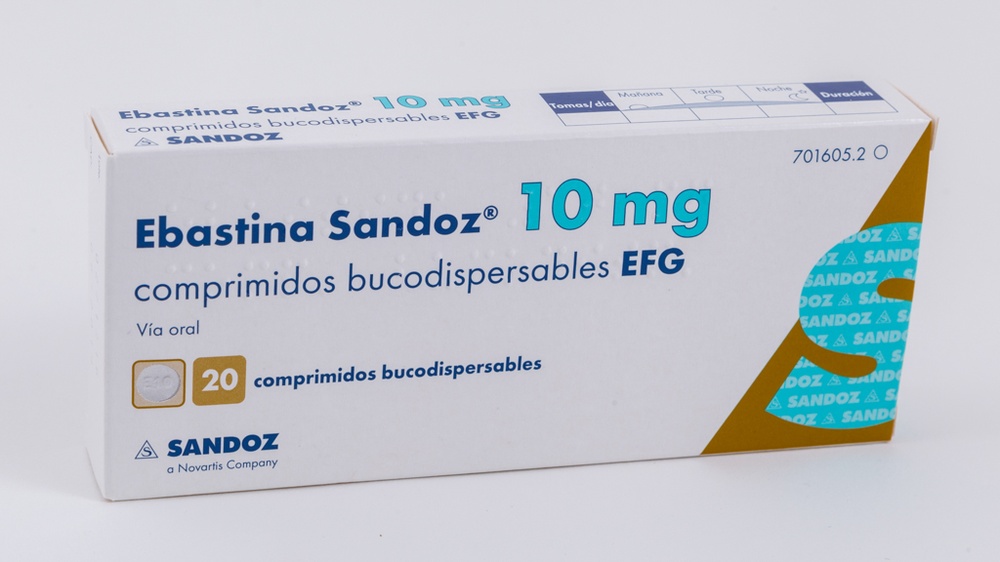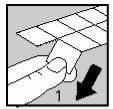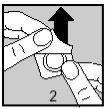

ЭБАСТИН САНДОЗ 10 мг ТАБЛЕТКИ ДЛЯ РАЗЖЕВАНИЯ/ДЛЯ ПЕРОРАЛЬНОГО РАССТВОРЕНИЯ

Спросите врача о рецепте на ЭБАСТИН САНДОЗ 10 мг ТАБЛЕТКИ ДЛЯ РАЗЖЕВАНИЯ/ДЛЯ ПЕРОРАЛЬНОГО РАССТВОРЕНИЯ

Инструкция по применению ЭБАСТИН САНДОЗ 10 мг ТАБЛЕТКИ ДЛЯ РАЗЖЕВАНИЯ/ДЛЯ ПЕРОРАЛЬНОГО РАССТВОРЕНИЯ
Введение
Инструкция: информация для пациента
Эбастин Сандоз 10 мг сублингвальные таблетки ЕФГ
Эбастин Сандоз 20 мг сублингвальные таблетки ЕФГ
Прочитайте внимательно всю инструкцию перед началом приема этого препарата, поскольку она содержит важную информацию для вас.
- Сохраните эту инструкцию, поскольку вам может потребоваться перечитать ее.
- Если у вас есть какие-либо вопросы, проконсультируйтесь с вашим врачом или фармацевтом.
- Этот препарат назначен вам, и не давайте его другим людям, даже если у них такие же симптомы, как у вас, поскольку это может нанести им вред.
- Если вы испытываете побочные эффекты, проконсультируйтесь с вашим врачом или фармацевтом, даже если это побочные эффекты, которые не указаны в этой инструкции. См. раздел 4.
Содержание инструкции
- Что такое Эбастин Сандоз и для чего он используется
- Что вам нужно знать перед началом приема Эбастина Сандоз
- Как принимать Эбастин Сандоз
- Возможные побочные эффекты
- Хранение Эбастина Сандоз
- Содержание упаковки и дополнительная информация
1. Что такое Эбастин Сандоз и для чего он используется
Эбастин - это антигистаминный препарат, который помогает облегчить симптомы аллергии, такие как: чихание, насморк, слезотечение, зуд кожи из-за сыпи.
Эбастин используется у взрослых и детей старше 12 лет для облегчения симптомов сезонного аллергического ринита (сенная лихорадка) и круглогодичного аллергического ринита, включая случаи с аллергическим конъюнктивитом.
Таблетки Эбастин 10 мг также используются у взрослых старше 18 лет для облегчения симптомов зуда и появления волдырей в случаях уртикарии (крапивницы).
2. Что вам нужно знать перед началом приема Эбастина Сандоз
Не принимайте Эбастин Сандоз:
- Если вы аллергичны к эбастину или любому другому компоненту этого препарата (перечисленному в разделе 6).
Предостережения и меры предосторожности
Проконсультируйтесь с вашим врачом или фармацевтом перед началом приема Эбастина Сандоз, если:
- вы уже принимаете определенные антибиотики или препараты, используемые для лечения грибковых инфекций: см. раздел «Прием Эбастина Сандоз с другими препаратами» ниже,
- у вас тяжелое нарушение функции печени (печеночная недостаточность).
Дети и подростки
Этот препарат должен использоваться только у детей старше 12 лет. Не давайте этот препарат детям младше 12 лет, поскольку не установлена его безопасность и эффективность в этой возрастной группе.
Прием Эбастина Сандоз с другими препаратами
Сообщите вашему врачу или фармацевту, если вы принимаете, недавно принимали или можете принимать любой другой препарат.
Если вы принимаете эбастин вместе с эритромицином (антибиотиком), кетоконазолом или итраконазолом (препаратами для лечения грибковых инфекций), это может увеличить уровень эбастина в крови.
Совместное применение эбастина и рифампицина (противотуберкулезного препарата) может привести к снижению уровня эбастина в крови и, следовательно, к снижению его эффекта.
Не рекомендуется одновременный прием эбастина с кларитромицином илиโจзамицином (антибиотиками).
Прием Эбастина Сандоз с пищей и напитками
Эбастин Сандоз можно принимать с пищей или без нее.
Беременность, лактация и фертильность
Нет достаточных данных о безопасности этого препарата для плода при использовании у человека. По этой причине эбастин должен использоваться во время беременности только в тех случаях, когда ваш врач считает, что польза превышает возможные риски.
Не принимайте эбастин, если вы кормите грудью, поскольку неизвестно, выделяется ли активное вещество в грудное молоко.
Если вы беременны, кормите грудью, думаете, что могли стать беременными или планируете беременность, проконсультируйтесь с вашим врачом или фармацевтом перед использованием этого препарата.
Вождение и использование машин
Большинство пациентов, принимающих эбастин, могут водить транспорт или выполнять другие действия, требующие быстрой реакции. Однако, как и с другими препаратами, проверьте вашу индивидуальную реакцию после приема эбастина перед тем, как водить или выполнять сложные действия, поскольку некоторые пациенты могут испытывать сонливость или головокружение.
Эбастин Сандоз содержит лактозу, аспартам и натрий.
Этот препарат содержит лактозу. Если ваш врач сказал вам, что у вас непереносимость некоторых сахаров, проконсультируйтесь с ним перед приемом этого препарата.
Этот препарат содержит 2,5 мг аспартама (Е951) на таблетку 10 мг и 5 мг аспартама (Е951) на таблетку 20 мг. Аспартам содержит источник фенилаланина, который может быть вреден при фенилкетонурии (ФКН), редком генетическом заболевании, при котором фенилаланин накапливается из-за того, что организм не может правильно его удалить.
Этот препарат содержит менее 23 мг натрия (1 ммоль) на сублингвальную таблетку, что означает, что он практически не содержит натрия.
3. Как принимать Эбастин Сандоз
Следуйте точно инструкциям по приему этого препарата, указанным вашим врачом или фармацевтом. В случае сомнений проконсультируйтесь с вашим врачом или фармацевтом.
Рекомендуемая доза:
Показание | Возраст | Доза |
Аллергический ринит В случае сильных симптомов | Дети старше 12 лет и взрослые | Одна таблетка эбастина 10 мг (10 мг эбастина) один раз в день. Две таблетки эбастина 10 мг или одна таблетка эбастина 20 мг (20 мг эбастина) один раз в день. |
Уртикария | Взрослые старше 18 лет | Одна таблетка эбастина 10 мг (10 мг эбастина) один раз в день. |
У пациентов с нарушением функции почек коррекция дозы не требуется.
У пациентов с легким или умеренным нарушением функции печени коррекция дозы не требуется.
Нет опыта использования доз выше 10 мг у пациентов с тяжелой печеночной недостаточностью, поэтому доза не должна превышать 10 мг у этих пациентов.
Не давите на таблетку, чтобы вынуть ее из ячейки, поскольку она может разломаться.
Каждый блистер содержит таблетки, разделенные отдельными ячейками с перфорацией.
Отрежьте одну ячейку по перфорации (Рисунок 1)

Затем осторожно удалите алюминиевую пленку, отделив ее от угла, указанного стрелкой (Рисунки 2 и 3).


Держите руки сухими, чтобы вынуть таблетку из ячейки.
Положите таблетку на язык, где она растворяется в течение нескольких секунд, нет необходимости принимать воду или любой другой напиток.
Эбастин можно принимать с пищей или без нее.
Ваш врач укажет продолжительность лечения.
Если вы приняли слишком много Эбастина Сандоз
Нет специального антидота для активного вещества эбастин.
В случае передозировки эбастином проконсультируйтесь с вашим врачом. В зависимости от тяжести отравления ваш врач примет необходимые меры (мониторинг жизненно важных функций, включая мониторинг ЭКГ в течение не менее 24 часов, симптоматическое лечение и промывание желудка), если это необходимо.
В случае передозировки или случайного приема проконсультируйтесь немедленно с вашим врачом или фармацевтом или позвоните в Службу токсикологической информации, телефон: 91 562 04 20, указав препарат и количество, принятое.
Если вы пропустили прием Эбастина Сандоз
Не принимайте двойную дозу, чтобы компенсировать пропущенные дозы.
Если у вас есть какие-либо другие вопросы о приеме этого препарата, проконсультируйтесь с вашим врачом или фармацевтом.
4. Возможные побочные эффекты
Как и все препараты, этот препарат может вызывать побочные эффекты, хотя не все люди испытывают их.
Прекратите принимать Эбастин Сандоз и немедленно проконсультируйтесь с вашим врачом или обратитесь в ближайшую больницу, если происходит следующее:
Тяжелая аллергическая реакция, вызывающая зуд и отек лица, языка или горла, и которая может вызвать трудности с глотанием или дыханием.
Тяжелые аллергические реакции на эбастин редки (могут поражать до 1 из 1000 человек).
Другие побочные эффекты включают:
Очень частые побочные эффектымогут поражать более 1 из 10 человек
- головная боль.
Частые побочные эффектымогут поражать до 1 из 10 человек
- сонливость
- сухость во рту.
Редкие побочные эффектымогут поражать до 1 из 1000 человек
- нервозность, бессонница,
- головокружение, снижение чувствительности, нарушение вкуса,
- сердцебиение, учащенное сердцебиение,
- боль в животе, рвота, тошнота, изжога,
- воспаление печени (гепатит), проблемы с выведением желчи (холестаз), аномальные результаты анализов функции печени,
- кожная сыпь, крапивница, воспаление кожи,
- нарушения менструального цикла,
- отек (накопление жидкости в тканях), слабость (астения).
Частота не известна: не может быть оценена на основе доступных данных
- прибавка в весе,
- повышение аппетита.
Сообщение о побочных эффектах
Если вы испытываете любой побочный эффект, проконсультируйтесь с вашим врачом или фармацевтом, даже если это возможные побочные эффекты, которые не указаны в этой инструкции. Вы также можете сообщить о них напрямую через Систему фармаковигиланса лекарственных средств для человека: http://www.notificaram.es. Сообщая о побочных эффектах, вы можете внести свой вклад в предоставление более полной информации о безопасности этого препарата.
5. Хранение Эбастина Сандоз
Храните этот препарат в недоступном для детей месте.
Не используйте этот препарат после срока годности, указанного на блистере и упаковке после «Срок годности». Срок годности - последний день месяца, указанного.
Храните в оригинальной упаковке, чтобы защитить от света.
Препараты не должны выбрасываться в канализацию или мусор. Поместите упаковку и препарат, который вам не нужен, в пункт SIGRE аптеки. Если у вас есть сомнения, проконсультируйтесь с вашим фармацевтом, как избавиться от упаковки и препарата, который вам не нужен. Таким образом, вы поможете защитить окружающую среду.
6. Содержание упаковки и дополнительная информация
Состав Эбастина Сандоз
- Активное вещество - эбастин.
- Эбастин Сандоз 10 мг: каждая сублингвальная таблетка содержит 10 мг эбастина.
- Эбастин Сандоз 20 мг: каждая сублингвальная таблетка содержит 20 мг эбастина.
- Другие компоненты - микрокристаллическая целлюлоза, лактоза моногидрат, кукурузный крахмал, натрия кроскармеллоза, аспартам (Е951), мятный аромат, коллоидный диоксид кремния и стеарат магния.
Внешний вид продукта и содержание упаковки
Сублингвальная таблетка.
Эбастин Сандоз 10 мг:
Белые, биконвексные, круглые таблетки диаметром примерно 6,7 мм, маркированные «Е10» на одной стороне и гладкие на другой стороне.
Эбастин Сандоз 20 мг:
Белые, биконвексные, круглые таблетки диаметром примерно 9,2 мм, маркированные «Е20» на одной стороне и гладкие на другой стороне.
Таблетки упакованы в блистеры ОПА/Алю/ПВХ/Алю, помещенные в картонные упаковки.
Упаковочные размеры:
Эбастин Сандоз 10 мг:
10, 20, 30, 40, 50, 90, 98 или 100 сублингвальных таблеток.
Эбастин Сандоз 20 мг:
10, 15, 20, 30, 40, 50, 98 или 100 сублингвальных таблеток.
Возможно, не все упаковочные размеры доступны.
Владелец разрешения на продажу и ответственный за производство
Владелец разрешения на производство
Сандоз Фармацевтика, С.А.
Центр бизнеса Парке Норте
Здание Робле
Улица Серрано Гальваче, 56
28033 Мадрид
Испания
Ответственный за производство
Лек Фармацевтика д.о.о.
Веровшкова 57,
1526 Любляна
Словения
Тева Фармацевтические работы Частная компания
Паллаги ут 13, 4042 Дебрецен
Венгрия
или
Тева Фарма, С.Л.У.
Улица Анабель Сегура 11, Здание Альбатрос Б, 1-й этаж, Алькобендас, 28108
Мадрид
Испания
Этот препарат разрешен в государствах-членах Европейского экономического пространства под следующими названиями:
Бельгия: Эбастин Сандоз 10 мг сублингвальные таблетки
Италия: Эбастин Сандоз
Швеция: Эбастин Сандоз, 10 мг сублингвальная таблетка
Эбастин Сандоз, 20 мг сублингвальная таблетка
Дата последнего пересмотра этой инструкции:август 2020
Подробная информация о этом препарате доступна на сайте Агентства по лекарственным средствам и медицинским изделиям Испании (АЕМПС) http://www.aemps.gob.es/

Сколько стоит ЭБАСТИН САНДОЗ 10 мг ТАБЛЕТКИ ДЛЯ РАЗЖЕВАНИЯ/ДЛЯ ПЕРОРАЛЬНОГО РАССТВОРЕНИЯ в Испании в 2025 году?
Средняя цена на ЭБАСТИН САНДОЗ 10 мг ТАБЛЕТКИ ДЛЯ РАЗЖЕВАНИЯ/ДЛЯ ПЕРОРАЛЬНОГО РАССТВОРЕНИЯ в ноябрь, 2025 года составляет около 4.4 евро. Финальная стоимость может зависеть от региона, конкретной аптеки и рецептурного статуса. Для точной информации лучше проверить онлайн или в ближайшей аптеке.
- Страна регистрации
- Средняя цена в аптеках4.4 EUR
- Активное вещество
- Требуется рецептДа
- Производитель
- Информация носит справочный характер и не является медицинской рекомендацией. Перед приемом любых препаратов проконсультируйтесь с врачом. Oladoctor не несет ответственности за медицинские решения, принятые на основе этого контента.
- Аналоги ЭБАСТИН САНДОЗ 10 мг ТАБЛЕТКИ ДЛЯ РАЗЖЕВАНИЯ/ДЛЯ ПЕРОРАЛЬНОГО РАССТВОРЕНИЯФорма выпуска: ТАБЛЕТКА, 10 мг эбастинаАктивное вещество: ЭбастинПроизводитель: Laboratorios Almirall S.L.Не требуется рецептФорма выпуска: ТАБЛЕТКА, РАСПАДАЮЩАЯСЯ ВО РТУ / ЛИОТАБ, 10 мгАктивное вещество: ЭбастинПроизводитель: Laboratorios Almirall S.L.Не требуется рецептФорма выпуска: ТАБЛЕТКА, 20 мг эбастинаАктивное вещество: ЭбастинПроизводитель: Laboratorios Almirall S.L.Не требуется рецепт
Аналоги ЭБАСТИН САНДОЗ 10 мг ТАБЛЕТКИ ДЛЯ РАЗЖЕВАНИЯ/ДЛЯ ПЕРОРАЛЬНОГО РАССТВОРЕНИЯ в других странах
Лучшие аналоги с тем же действующим веществом и терапевтическим эффектом.
Аналог ЭБАСТИН САНДОЗ 10 мг ТАБЛЕТКИ ДЛЯ РАЗЖЕВАНИЯ/ДЛЯ ПЕРОРАЛЬНОГО РАССТВОРЕНИЯ в Польша
Аналог ЭБАСТИН САНДОЗ 10 мг ТАБЛЕТКИ ДЛЯ РАЗЖЕВАНИЯ/ДЛЯ ПЕРОРАЛЬНОГО РАССТВОРЕНИЯ в Украина
Врачи онлайн по ЭБАСТИН САНДОЗ 10 мг ТАБЛЕТКИ ДЛЯ РАЗЖЕВАНИЯ/ДЛЯ ПЕРОРАЛЬНОГО РАССТВОРЕНИЯ
Консультация по дозировке, побочным эффектам, взаимодействиям, противопоказаниям и продлению рецепта на ЭБАСТИН САНДОЗ 10 мг ТАБЛЕТКИ ДЛЯ РАЗЖЕВАНИЯ/ДЛЯ ПЕРОРАЛЬНОГО РАССТВОРЕНИЯ – по решению врача и с учетом местных правил.














